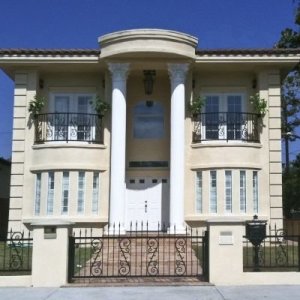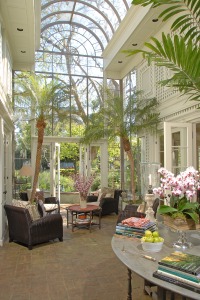
This monstrosity is a perfect example of what many builders and homeowners would call a modern version of an historical style but is just bad design
As residents of Los Angeles, we are faced on a daily basis with a variety of architectural styles that might leave us inspired or infuriated, accepting or angry, or perhaps somewhere in between, on a continuum of confusion, scratching one’s head over what some architect or developer hath wrought.
How did Los Angeles turn into such a dumping ground of confused architectural styles? Lack of education on the part of both builders and homeowners, I believe.
We are a city formed by periodic waves of long-distance immigrants, lured by the thought of a life that would be different, and hopefully better. People who came here in the last two centuries were true pioneers, as the geographical isolation sometimes meant a severance from all familiar ties. And perhaps this special kind of settler – the wanderer, the imaginative, the misfit, too – has contributed to the reputation we have as a land of the avant-garde.
These immigrants – both from foreign lands as well as from across the American continent – brought their architectural styles with them. In our domestic architecture, this reveals the importance we place on free expression, fun and leisure, and pretense and escapism. And so we have a mixture of many different styles – from fairytale dream cottages to nostalgic recreations of the roots left behind.
From Mission-era adobe structures, to eclectic Victorian mansions, to restful Arts and Crafts bungalows, to elegant Art Deco edifices, to Midcentury Modern Case Study Houses, all take a place in the panoply of styles that make up Los Angeles architecture.
And thus in building contemporary forms, some people have forgotten about our roots.

Lessons about good design can be learned from the legendary architect Paul R. Williams, who adapted to changing styles but always incorporated elegance, proportion, and scale into his works
Many try to completely destroy them. When I served as a Design Review Commissioner for the City of Beverly Hills, I was shocked by the lack of education on the parts of both homeowners and builders as to what good design actually constitutes. Many of the designs that came before the commission were displeasing from both an aesthetic as well as a construction standpoint, resulting in what one of my fellow commissioners dubbed “Mr. Potato Head architecture.” Many builders and homeowners would try to sneak some bad design past us, citing it as a modern version of an historical style. “Neo-whaaaaat?” my brain would often cry.
I think this lack of understanding of good design is the result of two converging forces: the training given by some architecture schools that encourage students to become “starchitects” rather than focusing on training them in traditional design, which has proven to have staying power through the ages; and homeowners who want to build bigger, not better, and who frankly, just don’t give a damn about historical precedence – or the neighbors, for that matter.

This garden room in a renovation of a Paul R. Williams-designed home by Gary Drake Construction demonstrates how a modern update can remain true to the elegance of its original design. Photo by Michael McCreary, Courtesy of Gary Drake Construction
Lessons about good design from both sides of the equation can be learned from the legendary architect Paul Revere Williams. When he designed, the design was not about him, it was about the building. Through his work and gentle manners, he educated his clients about good design. His architecture ultimately and completely stands up to the test of time. He understood and adapted to changing styles throughout the time period in which he designed, and yet he always incorporated elegance, proportion, and scale into his works.
So it is incumbent upon each of us to educate ourselves for the preservation of our Los Angeles architectural heritage. This does not mean that we should not build new buildings; rather, new construction should be sensitive to the surrounding neighborhood.
So what can you do to preserve what good design is left? If you’re building a house, take a class in design or architectural history. Trust me, we’re judging you and your taste behind your back, and it’s not pretty. Find an architect who knows good design and design history. Join your local neighborhood preservation group. Be vocal about bad development in your neighborhood. And leave those columns on the Greek and Roman temples, of which there are none in Los Angeles.
Warmest regards,
Eleanor



